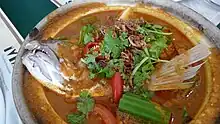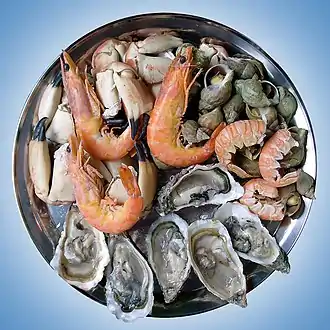 Fish head curry served at a Singaporean restaurant | |
| Alternative names | 咖哩魚頭 (Chinese) Kari kepala ikan (Malay) மீன் தலைக் கறி (Tamil) |
|---|---|
| Type | Curry |
| Course | Main course |
| Place of origin | Singapore[1][2][3] |
| Region or state | Southeast Asia |
| Created by | M.J. Gomez |
| Serving temperature | Hot or warm |
| Main ingredients | Red snapper fish head, vegetables (okra, eggplant, Long bean) |
| Variations | Fish amok, Fish head casserole, Ho mok pla, mok pa |
Fish head curry is a Singaporean dish deriving from a hybrid of Indian and Chinese ethnic cuisines.[1][2] The head of a red snapper is stewed in a curry with assorted vegetables such as okra and eggplants. It is usually served with either rice or bread, or as a shared dish.[4] The dish was first sold in a Singaporean restaurant called Gomez Curry in 1949.[5]
Description

Origins
Fish head curry was invented in Singapore when a chef from the state of Kerala named M.J. Gomez, who was living in the country, wanted to bring South Indian cuisine to local diners. He started a restaurant called Gomez Curry, which was located at Sophia Road and eventually at 9 Selegie Road, both located within the Rochor district in the Central Region.[1] The dish was first sold in 1949, at the restaurant opened by Gomez.[5]
Although fish head was not widely served in the Indian subcontinent, Chinese customers considered Fish head casserole as a special delicacy, and so Gomez had the idea of cooking the fish in curry instead, as well as his own ingredients, therefore formulating a new dish.[2]
Today, restaurants of all races in the country all serve variations of this dish. Fish head curry has become a popular dish among Singaporeans and tourists alike. Costing between S$10 to S$20, it is generally not considered cheap hawker fare. It typically comes served in a clay pot, and is often sold at hawker centers and neighbourhood food stalls.[4][6] Its popularity in Singapore also spread to neighboring countries, where it is also available in certain places in Malaysia and Indonesia today.
Preparation
Tamarind (asam) juice is frequently added to the gravy to give the dish a sweet-sour flavor (see asam fish). This variety of fish head curry also has a thinner, orange gravy.[7]
Coconut milk can be added to this dish.[8]
See also
- Singaporean cuisine
- Chilli crab – another Singaporean seafood dish
- Malabar matthi curry
- Fish head casserole
- Fish amok
- Fish stew
- Fish curry (disambiguation)
References
- 1 2 3 Jonas, Patrick (10 December 2017). "The man behind fish head curry". The Straits Times. Retrieved 2 September 2021.
He (M.J. Gomez) came to Singapore from Trivandrum, the capital of Kerala, in the 1930s before returning to get married. After the birth of his first child, a daughter, he returned to Singapore, only to get caught here during the war. Mr Gomez then came to Singapore again, and later brought his family over. They lived in Sophia Road, where he started his restaurant, Gomez Curry, which later moved to nearby Selegie Road.
- 1 2 3 Sterba, James P. (28 March 1979). "Singapore Special: Fish Head Curry". The New York Times. Retrieved 2 September 2021.
M. J. Gomez, the George Washington of fish head curry,. arrived in Singapore in 1928 from Trivandrum on the Malabar coast of India, which is now the state of Kerala. Now more than a dozen restaurants in Singapore serve it as their main course, often with just variety of curried crab, shrimp, other meats and vegetables as side dishes.
- ↑ Singapore Hawker Classics Unveiled: Decoding 25 Favourite Dishes. Marshall Cavendish. 2015. p. 69. ISBN 978-981-4677-86-8. Retrieved July 17, 2017.
- 1 2 Chan, M. (2 November 1986). Fish-head curry on a platter. The Straits Times, p. 4. Retrieved from NewspaperSG; Khoo, T., & Tay, L. (2015). The Singapore heritage cookbook: Past, present, future. Singapore: Food2Print Asia, p. 199. (Call no.: RSING 641.595957 KHO)
- 1 2 "Fish-head curry on a platter". The Straits Times, Archived by NewspaperSG. November 2, 1986. Retrieved July 6, 2023.
- ↑ "Fish head curry (gulai kepala ikan)". SBS.
- ↑ "Gulai Kepala Ikan ~ Resep". Tastemade.
- ↑ 1001 Foods To Die For. Andrews McMeel Publishing. 2007. p. 284. ISBN 978-0-7407-7043-2. Retrieved July 17, 2017.
